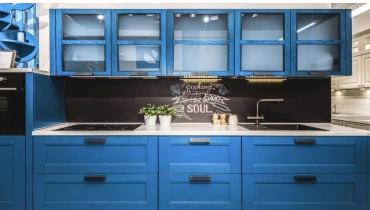
Five Star Painting explains how to paint melamine surfaces for a lasting finish.
|
Odds are if you have been inside a modern home recently, you have encountered melamine. Melamine, also known as MDL or Medium Density Laminate, is a material similar to plastic that is laid over pressboard and used in many different applications in houses built within the last 20 years. Melamine is a versatile and durable material that is great for things like cabinets and countertops and is resistant to all kinds of spills and damage.
If you have melamine cabinets or countertops, you may have wondered if you can paint them to give your kitchen some freshening up. There is nothing like a new coat of paint to make a kitchen look new again. While a whole remodel might be out of your price range, a coat of paint is a nice, budget-friendly alternative that can work wonders.
In this article, we will explain the difference between melamine and laminate, as well as give you some tips on how to properly paint melamine successfully. By following these steps, you can rejuvenate your kitchen without having to buy all new cabinets or countertops.
What is the Difference Between Melamine and Other Laminates?
Melamine is a common material, and its cousin, laminate, is even more common. While there are some similarities, they offer different levels of protection and have very different price ranges. Melamine is much less expensive and has a thinner consistency. It’s often used on the inside of cabinets but can be used on the outside as well.
However, even though they have a different thickness, melamine and laminate require many of the same steps for applying a coat of paint. The important thing is to do the job thoroughly and properly. Painting your cabinets is not an easy task and it takes a lot of preparation to end up with a quality finished product.
How to Paint Melamine
Remove Any Hardware or Doors and Drawers
Before you begin painting any melamine surface, you will have to be sure to remove any cabinet doors, drawers and hardware. In order to get an even and professional-looking paint job, it’s important the coat completely covers the entire surface area. Without removing the hardware, it will be very difficult to get to every area without inadvertently painting the hardware itself.
If you are painting your melamine cabinets, remove the doors and bring them to an area to be painted on their own. Removing the doors and drawers will ensure there are no areas for paint to get trapped, such as in the cracks of the doors themselves. It also helps to prevent dripping and spots where the paint could build up and not dry properly.
Clean Thoroughly
Cabinets and countertops are high-touch areas of your kitchen. Since these surfaces are so close to the stove and other cooking appliances, there may be spots on them where grease has built up over time. Before you begin painting, wipe down any surfaces with a high-quality cleaner or degreaser. If you don’t remove the grease, the paint won’t stick properly.
Sand with a Fine Grit Sandpaper
After you’ve cleaned the area completely, sand it with a fine-grit sandpaper. The grit of sandpaper gets finer the higher the grade is, so an appropriate grade number is between 80 and 120. Any rougher and you could run the risk of gouging the surface, which would be very difficult to cover up.
If your melamine surface has a grain to it, be sure to sand along the grain in long, gentle strokes. Sanding against the grain could also lead to gouging and it will need to be re-sanded properly. Melamine is very difficult to sand down, so it’s best to avoid this pitfall.
Use a High Adhesion Primer
Before applying the final finish, use a high adhesion primer. This usually comes in a spray can and is a mixture of paint and adhesive that will give you a solid, matte surface to paint onto. For best results, keep the can 10 to 12 inches away from the surface you’re spraying and use long, even strokes to get the best results. You may also brush and roll this primer using a high quality roller cover or brush.
Finish with a Satin or Semi-Gloss Paint
The best paint for the final finish of your melamine surface is a satin or semi-gloss paint. If you’re painting a high-touch area like a countertop, glossy paint may have a sticky consistency and will attract more dirt and grease, even after drying.
When painting the surface, paint with the grain and use your paint sparingly. You can always add more coats if necessary, and it’s better to apply too little than too much. Applying a coat that’s too thick could cause sticky areas and an uneven coat.
While it’s entirely possible to paint your melamine countertops or cabinets yourself, it’s quite a bit of work and isn’t easy to do properly. If you’re not comfortable doing such a big job in a high-traffic area like the kitchen, Five Star Painting can paint or refinish your melamine surfaces for much less than the cost of replacing them. Schedule a free estimate today to find out just how easy it can be!
This article is intended for general informational purposes only and may not be applicable to every situation. You are responsible for determining the proper course of action for your home and property. Five Star Painting is not responsible for any damages that occur as a result of this blog content or your actions. For the most accurate guidance, contact the Five Star Painting location nearest you for a comprehensive, on-site assessment.
FAQs About Painting Melamine
Our years of experience, attention to detail, and decades-long commitment to exceptional customer service set Five Star Painting apart from the competition. Continuing this high standard also includes using our knowledge and experience to answer your most frequently asked questions about painting melamine.
Is sanding necessary before painting melamine?
Sanding before you paint melamine is highly recommended and often necessary for a durable and professional-looking finish.
Here's how to sand melamine before painting:
- Clean: Thoroughly clean the melamine surface with a degreaser or detergent solution to remove any dirt, grease, or residue. Rinse and let it dry completely.
- Choose sandpaper: Use medium-grit sandpaper, typically between 120 and 150 grit. You don't need anything too coarse.
- Sand lightly: Apply light, even pressure. The goal is not to remove the melamine layer, but simply to dull the glossy finish and create a slightly rough texture. Work systematically across the entire surface.
- Wear protection: Wear eye protection and a dust mask to avoid inhaling sanding dust.
- Clean again: After sanding, it's crucial to remove all sanding dust. Wipe the surface with a tack cloth or a slightly damp microfiber cloth. Ensure the surface is completely clean and dry before priming.
Melamine has a very smooth, non-porous, plastic-like surface. This slickness prevents paint from adhering properly. Without adequate surface preparation, the paint is very likely to peel, chip, or scratch off easily over time.
Sanding overcomes this issue by lightly abrading or “scuffing” the surface. This removes the factory sheen and creates tiny scratches that give the primer and paint something to adhere to, ensuring much better adhesion and longevity. While some specialized bonding primers claim to work on slick surfaces without sanding, lightly sanding first provides the best insurance against paint failure.
Can I use chalk paint on melamine?
You can use chalk paint on melamine. Chalk paint is renowned for its adhesive qualities, often sticking to surfaces with minimal preparation compared to traditional paints.
However, because melamine is exceptionally smooth and non-porous, taking a few preparatory steps is highly recommended for long-lasting results:
- Thoroughly cleaning the melamine surface to remove any grease or grime.
- Lightly scuff-sand the melamine with medium-grit sandpaper (around 150 grit).
- Wipe away all dust before painting melamine.
- Seal the chalk paint with wax or a clear topcoat for durability.
How do I keep painted melamine from chipping?
Preventing painted melamine from chipping requires careful preparation, application, and ongoing care.
Here's how to keep painted melamine from chipping:
- Handle with care: Avoid harsh impacts and friction on the painted surface. Use felt pads under items placed on painted melamine surfaces.
- Clean gently: Clean painted melamine with a soft, damp cloth and mild soap. Avoid abrasive cleaners or scrubbing, which can damage the paint.
- Touch up chips promptly: If chips do occur, address them quickly with touch-up paint to prevent further damage.
Before you paint melamine chips, contact your local Five Star Painting team to learn how a service professional can help restore and preserve your painted surfaces for the long run.


